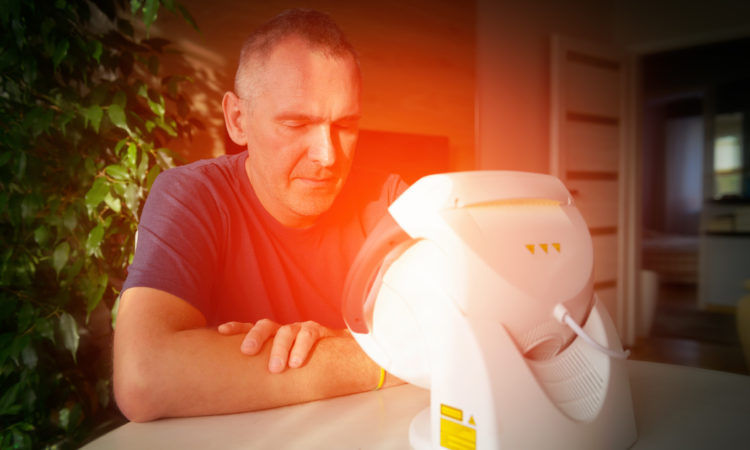
Once confined to scientific laboratories and expensive spas, red light treatment is now a popular trend.
Many health and biohacking gurus promote it, and so do some respectable medical authorities. They include Dr. Michael Hamblin. As an Associate Professor of Dermatology at Harvard Medical School, he’s obviously credible.
Scientific study of red light therapy goes back over a hundred years. Niels Ryberg Finsen won the 1903 Nobel Prize for his work in studying red light therapy to treat skin diseases.
Just so we’re clear: this article refers to red light and near-infrared light (NIR), not to heat lamps.
Red light advocates say red light and NIR can help heal wounds, grow hair, reduce joint pain & inflammation, improve cognitive function, increase testosterone in men, improve sleep quality, decrease workout reocovery times and, simply, boost energy and slow down aging.
Get More Sunlight
Some red light advocates do say at least some of its benefits come from setting your circadian rhythm – your bioclock.
That makes sense, but you can do that simply by exposing yourself to light from the thermonuclear fusion reactor 93 million miles over our heads – the sun. It’s free.
In the two hours after you normally wake up every morning, get as much light as possible. Outdoors if you can, but indoor light counts too. Also in this period, eat and exercise.
All that signals “morning” to your body.
What About Other Health Claims?
Red light and NIR affect the mitochondria in your cells. Those are the powerhouses that supply you with the ATP you use for energy.
This gets sort of choked off when nitric oxide (NO) binds with an enzyme (CCO) that’s key to cellular respiration. When bonded, they block the production of ADP, which comes before ATP. Less ADP = less ATP = less energy so you feel tired and sluggish.
During the final phase of the process – oxidative phosphorylation – red light breaks the bonds between NO and CCO.
That allows your mitochondria to produce more ATP – more energy for your cells.
And NO is an important compound in its own right for relaxing your blood vessels, and has many more health benefits.
My Theory as to How Red Light Produces Energy in Our Bodies – One Way, At Least
If you ever shined a flashlight against your hand when you were a kid, you know strong light does go through our skin.
That includes the red wavelengths of sunlight when you’re outside on a sunny day.
When that sunlight encounters chlorophyll – from plants you’ve eaten – it can regenerate coenzyme Q10. That’s a key compound in your mitochondria which helps them make ATP.
Therefore, regenerating coenzyme Q10 may be one factor causing the reported health benefits of exposure to red light.
Do You Need to Buy a Red Light Device?
The claims red light advocates make are generally backed up by studies, although there are no large, major studies pushing red light into the mainstream of medical practice.
The evidence for using red light at home simply for more energy or to live longer does not yet exist. Right now, we’ve got claims by enthusiastic users, but not controlled trials demonstrating long-term results.
Still, there’s enough evidence red light and NIR have some health benefits to say, go ahead if it sounds good to you.
If you use red light and NIR responsibly with safe equipment, there’s little risk.
Eating a great diet, exercising and sleeping 7-9 hours per night are all probably much more important.
But adding 10-20 minutes per day of red light exposure to your health practices won’t hurt, and might help, you.
Just understand: quality red light devices aren’t cheap.
Buyer Beware:
1. Make sure the device’s production has been approved by the Food and medicine Administration. That requires every part of the device to pass high safety and quality specifications. That means the device itself is safe.
If it’s not approved by the FDA, do NOT buy.
2. One way of comparing devices is Total Delivered Power.
However, that’s not easy to determine. Therefore, avoid devices from manufacturers that don’t have their lights measured by independent third parties.
3. Look only for devices that deliver red light in the 630-670 nm range and near-infrared red light in the 810-880 nm range.
Those are the ranges that have been mainly used in the studies showing health benefits.
Avoid devices that use ranges of red and NIR light that have no proven health benefits.
4. Avoid devices with cheap LEDs with significant flicker. Also, some brands use LEDs that are actually white or blue, but covered with a red filter. Make sure the red LEDs are really red LEDs.
Safety:
1. Follow the manufacturer’s directions.
2. Red and NIR light in the proven frequencies is not dangerous, as long as it’s not so bright it hurts your eyes. Avoid any light that does that.
However, 10-20 minutes of daily exposure seems to be all you need to get the health benefits – so don’t use it longer than that unless directed by your doctor.
https://www.youtube.com/watch?v=t5yrX1clx7o
https://canadianbiohacker.com/hack-aging-red-light/
https://bengreenfieldfitness.com/article/biohacking-articles/red-light-therapy-benefits/
https://www.youtube.com/watch?v=Pr3kuabexV4&t=0
https://www.inverse.com/mind-body/red-light-therapy
https://www.webmd.com/skin-problems-and-treatments/red-light-therapy
https://nutritionfacts.org/video/how-to-regenerate-coenzyme-q10-coq10-naturally/
https://www.healthline.com/nutrition/coenzyme-q10#TOC_TITLE_HDR_1
https://www.youtube.com/watch?v=C00oDKGK1uo
https://www.youtube.com/watch?v=xVeFlKOTxVg







